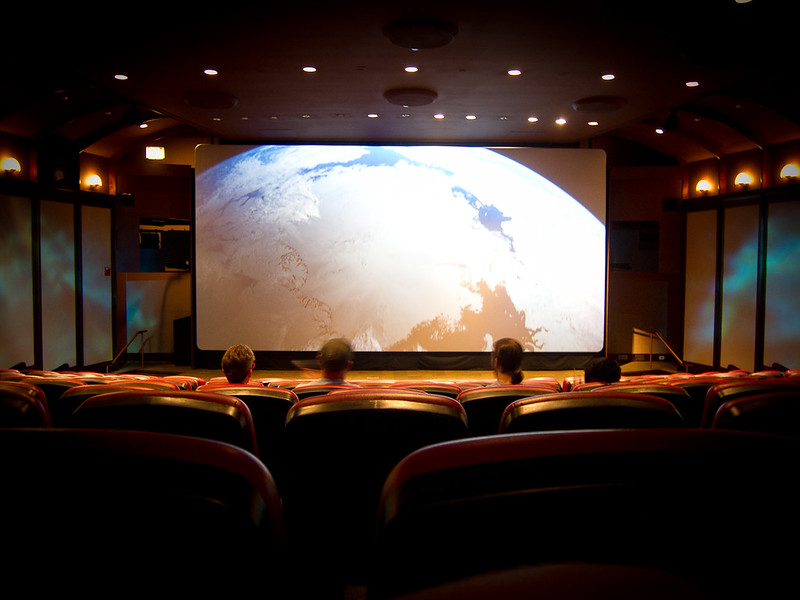4D theaters: The Future of Cinema or Just a Gimmick?
Audience members at a 4D theater in an aquarium in Chicago
Movie theaters are dying. It was happening before COVID, and the pandemic only exacerbated things. Arclight Cinemas, previously one of the most reputable names in the movie-going experience, shut down. AMC’s earnings per share has been negative for eight straight quarters. 61% of Americans didn’t go to a movie theater last year. Even in 2019, a year that produced huge movies like Once Upon a Time in Hollywood, Avengers: Endgame, and Knives Out, 46% of adults went to the movies one time or less.
Is there any way to save them?
The ideal solution would simply be the general public realizing the value of seeing more movies in the theater. But that’s not the most realistic option. Audiences consume media differently now. The biggest change is the advent of streaming, which allows would-be theatergoers to watch the movies at home in only a few weeks.
So what could set theaters apart from the home-viewing experience? The implementation of 4D technology.
You’ve probably already experienced the 4D concept. Rides like Star Tours at Disneyland or the Dreamworks Theatre at Universal Studios Hollywood are both examples that take up space in popular theme parks. There are also quite a few at museums all over the country. Even though they look almost exactly like a normal theater, they include seats that move, water sprayers, and the “creepy crawly effect,” in which it feels like there are bugs moving around your feet. It can immerse the viewer in the world of the movie or short film, or at least provide tactile stimulation during the viewing.
Despite the general success at theme parks, it is rare to find a place to watch an actual movie in 4D. After all, an uncomfortable experience with the technology could ruin the movie. However, that hasn’t stopped Regal Cinemas from adding multiple 4D theaters to various locations.
With tentpole films like The Batman being offered in 4D, I went to see Raiders of the Lost Ark at the Regal North Hollywood to see if the possible new form of watching movies was as fun as they claim. And if it wasn’t, I would at least get to watch one of my favorite movies on the big screen.
Movement:
As the main draw of the 4D experience, it was not a surprise that the chair’s movement ended up being the most heavily used effect, and it was fairly effective. This feature includes the chairs vibrating, moving, and bucking to replicate what the object of focus is going through at that time in the movie. While the movement during the action scenes, albeit a little jerky, was effective, the best feature was the atmosphere setting. During the opening credits, the seats crept up little by little to create suspense, which paid off when the temple traps started to activate. If there was one negative, it was the lack of consistency in the movement. While the advertisements promise to put you in the place of the hero, the seats moved in conjunction with several focal objects. These objects include but are not limited to the protagonist, the cars, the antagonists, and the camera. While this doesn’t ruin the experience, it breaks from the immersion a bit.
Other Effects:
There were several advertised aspects of the experience that aren’t based in movement. One of these is the effect of bugs crawIing around you. If there’s any movie series famous for creepy-crawlies, it’s the Indiana Jones tetralogy. In the opening scene, multiple characters get tarantulas all over their backs. There are also the snakes that the title character is very famously scared of. However, this effect seemed to be either not working, not effective, or not present. At no point did it feel like snakes were under or on me.
Contrasting this, the air and wind effects were very heavily used. The Nazi-face-melting scene turned the wind effects up to 10 and left me shivering due to the cold when it ended. However, the rest of the listed features, including air shots and scent technology weren’t included.
Raiders of the Lost Ark isn’t really a ‘water movie’. So maybe it was a conscious choice that I only felt one water feature, and even then very lightly. My pre-show inspection of the seats showed me that the water sprayer was pointed towards the feet, and was small enough that it could have missed me each time.
Seeing light is the only advertised feature that is a visual experience.. You know what else is a visual experience? The movie! It’s not really ‘another dimension’ to the medium of film. That said, it actually wasn’t bad. There were lights at around the eighth row of the theater that emit bright flashes. The lights weren’t close enough to the screen to impair the movie-viewing experience. It surprised me how well it was handled, but I hope they don’t add more for fear of taking away from the movie.
OVERALL GRADE: B
So is 4D the way of the future? It mostly worked with Raiders. However, I don’t think it will become the new norm. For one, it doesn’t work with dramas or comedies. The cost of installing the theaters into every space would certainly outweigh the revenue those movies bring in. The second reason is motion sickness or just general dislike towards simulators. There are plenty of people who would stop going to theaters if their seats were moving the whole time. This could be remedied with an option to turn off the movement, sure, but it would require an entire reworking of the system. The chairs are grouped in quartets of four, so a rehaul would be necessary. So the verdict? 4D will certainly populate the movie theater locations, but will likely only take up a couple of theaters at each location. And it certainly won’t save movie theaters.

Micah Green is a senior at Milken, in his third year as a writer for The Roar. He is excited to be the Co-Editor-in-Chief and the producer for The Milken...



